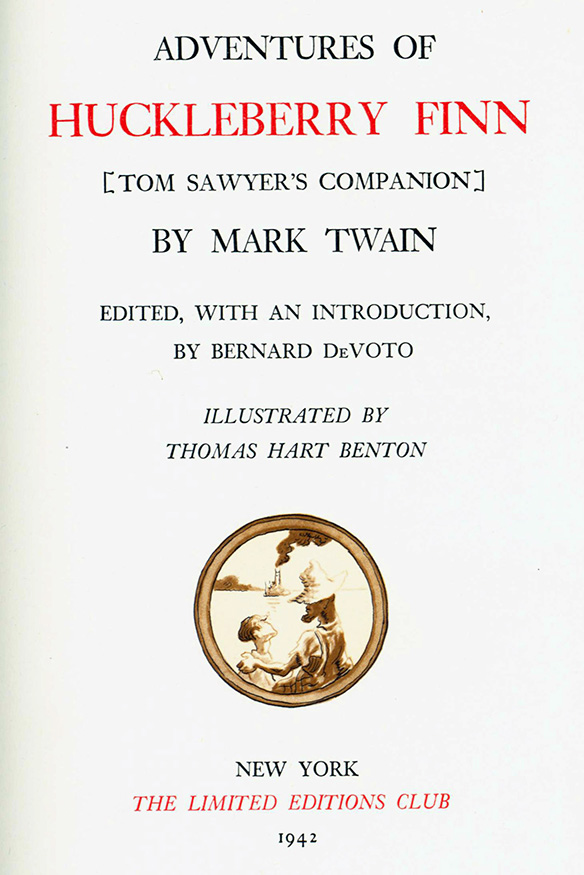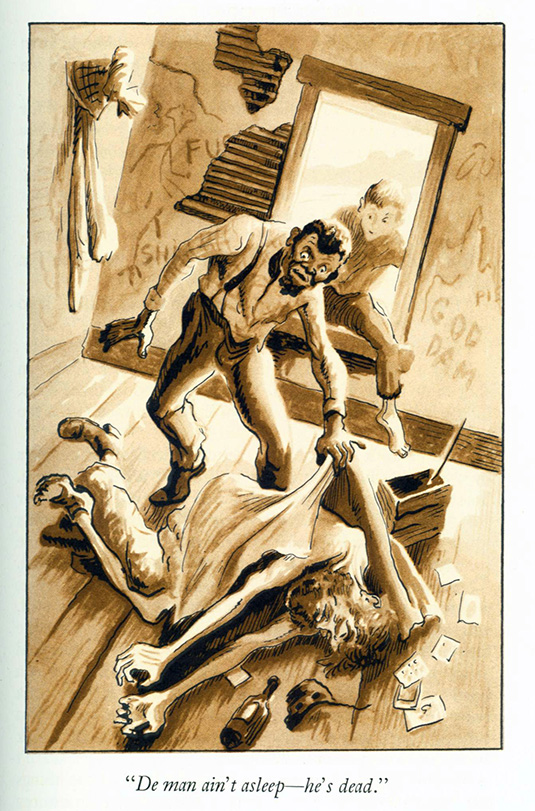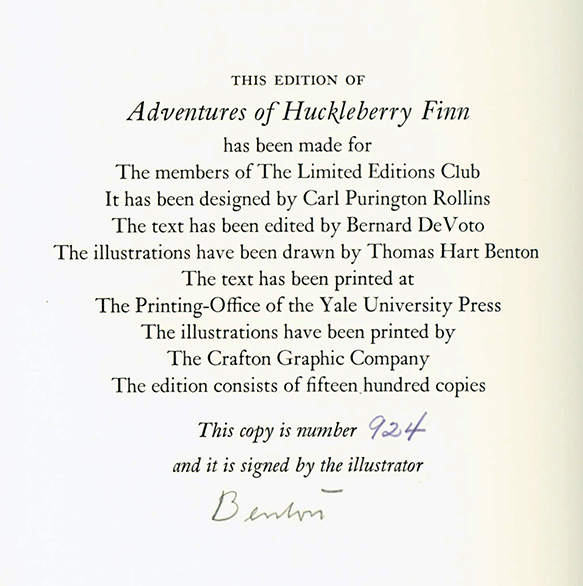By: Savannah Gulick, ARB Student Assistant
 In my Honors seminar, “The Culture of Books and Reading,” we were asked to choose a rare book from the holdings of the Archives & Rare Books Library to analyze and write about, and the book I chose was The Adventures of Huckleberry Finn by Mark Twain (a personal favorite of mine). Our first task was to analyze the physical features of our chosen books. Prior to this class, I really never cared to thoroughly look over a book; rather, I would just dive right in to the story. It truly is surprising how much you can learn from just examining a book. What I found about my book, just by looking, was that it is a limited edition (only 1500 copies produced), published in 1942 by The Limited Editions Club. The book is hardcover and bound in a typical library buckram that is colored mustard yellow. Considering it was issued in 1942, the printing is very clean and still in good condition on sturdy, white pages. This limited edition contains 45 illustrations done by the Americana artist Thomas Hart Benton and they’re beautiful, fitting right in with the theme of Twain’s novel. Overall, the book contains 396 pages and is still in good condition.
In my Honors seminar, “The Culture of Books and Reading,” we were asked to choose a rare book from the holdings of the Archives & Rare Books Library to analyze and write about, and the book I chose was The Adventures of Huckleberry Finn by Mark Twain (a personal favorite of mine). Our first task was to analyze the physical features of our chosen books. Prior to this class, I really never cared to thoroughly look over a book; rather, I would just dive right in to the story. It truly is surprising how much you can learn from just examining a book. What I found about my book, just by looking, was that it is a limited edition (only 1500 copies produced), published in 1942 by The Limited Editions Club. The book is hardcover and bound in a typical library buckram that is colored mustard yellow. Considering it was issued in 1942, the printing is very clean and still in good condition on sturdy, white pages. This limited edition contains 45 illustrations done by the Americana artist Thomas Hart Benton and they’re beautiful, fitting right in with the theme of Twain’s novel. Overall, the book contains 396 pages and is still in good condition.
After looking over the physical aspects, it was time to delve into the intellectual features. As mentioned above, this edition of The Adventures of Huckleberry Finn was published in New York in 1942. The editor of this edition was Bernard DeVoto who – after a little bit of ‘googling’ – I discovered was the executor of the Twain Literary Estate. As most people know, the novel revolves  around the lives of Tom Sawyer, Huck Finn, the Widow Douglas, Miz Watson, and Jim in Mississippi around 1835-1845 and is the sequel to The Adventures of Tom Sawyer. The book here at UC is copy 924 of 1500, which is detailed on the colophon, along with the signature of the illustrator, Benton.
around the lives of Tom Sawyer, Huck Finn, the Widow Douglas, Miz Watson, and Jim in Mississippi around 1835-1845 and is the sequel to The Adventures of Tom Sawyer. The book here at UC is copy 924 of 1500, which is detailed on the colophon, along with the signature of the illustrator, Benton.
Huckleberry Finn replicates Twain’s mastery of colloquial speech and mirrors the writing of Tom Sawyer. At the time of the first edition’s publication in 1884-85, Twain knew his book would reach a diverse audience but intended its true meaning to be understood by an older audience who would appreciate the themes and the humor. Since its initial publication, the book has been widely enjoyed by a vast range of people but continually receives a spotlight since it is so often on the list of banned books for the use of a racial slur, and in its earliest days, for its “common” use of language. Published three years before end of World War II, this Limited Editions Club edition was meant for a market targeted to the people who could afford a spcial book for their personal libraries. Considering the circumstances of the war and Nazi Germany’s racism, Twain’s novel being republished in this era might have served as a reminder to Americans that racism occurred in the United States decades prior to the 1940s and still existed at that point in time.
 The last thing we were asked to do was to assess the value of the book in one sentence. How does one assess such a classic novel in one sentence? I wasn’t entirely sure myself until I found a copy of the book being sold now and realized how much it was worth. To me, it seems that the value of the book is primarily monetary since there were so few copies produced and as a collectible, they included the illustrator’s signature. But in conjunction with other editions of Adventures of Huckleberry Finn held by the Archives & Rare Books Library, including the first edition, this volume’s importance lies as well in documenting American printing history and the reading heritage of Twain’s work.
The last thing we were asked to do was to assess the value of the book in one sentence. How does one assess such a classic novel in one sentence? I wasn’t entirely sure myself until I found a copy of the book being sold now and realized how much it was worth. To me, it seems that the value of the book is primarily monetary since there were so few copies produced and as a collectible, they included the illustrator’s signature. But in conjunction with other editions of Adventures of Huckleberry Finn held by the Archives & Rare Books Library, including the first edition, this volume’s importance lies as well in documenting American printing history and the reading heritage of Twain’s work.
